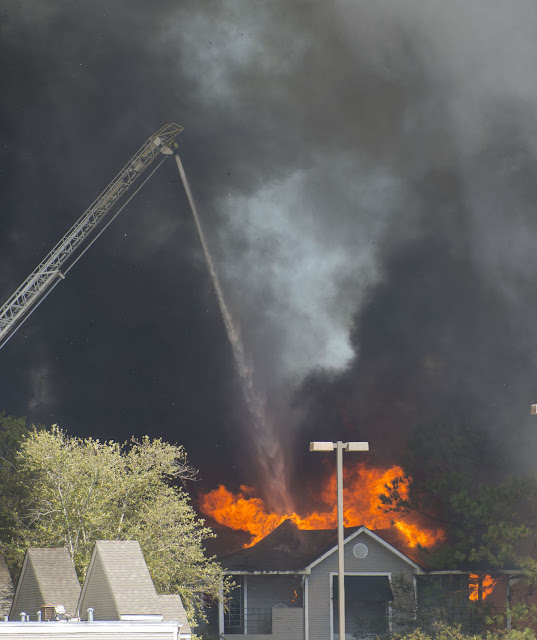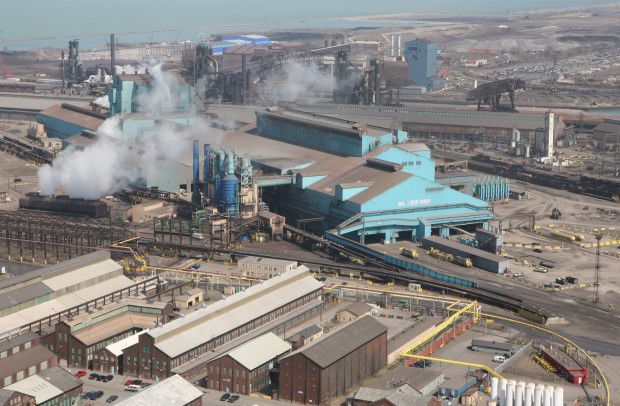BY BRYN STOLE | bstole@theadvocate.com
Updated Oct 6, 2016 at 5:36 pm
At least five people were reported injured, including two firefighters, in a huge fire at the Cobblestone apartment complex on Essen Lane Thursday afternoon that completely destroyed two apartment buildings and damaged dozens of surrounding units, authorities said.
Most of the top two stories of the three-story units collapsed during the blaze, with only charred studs and twisted metal remaining. Several cars in the parking lot of the large apartment complex burned up, and vinyl siding on neighboring buildings as far as 100 feet away peeled and melted off facades in the intense heat radiating from the buildings.
The blaze, which residents said broke out shortly before 1 p.m., sent a large plume of black smoke billowing from the complex, located just south of Interstate 10. Three ladder trucks from St. George and Baton Rouge fire departments and several crews of firemen poured thousands of gallons of water on the buildings as stunned residents and neighbors looked on.
At 3 p.m., the incident commander from St. George Fire Department declared the flames under control, though firefighters continued dousing hot spots in the smoldering buildings late into the afternoon.

Multiple injuries as Cobblestone Apartment complex fire in Baton Rouge
The Advocate

Two residents were taken to the hospital for burns, said Mike Chustz, a spokesman for EMS. Information about the extent of their injuries was not known as of late Thursday afternoon. A St. George firefighter was treated at the scene for heat stroke, while another fireman and a East Baton Rogue sheriff's deputy were both treated by paramedics for symptoms of smoke inhalation, said Eldon Ledoux, a St. George Fire spokesman.
Ledoux said no residents of the buildings were reported missing but that firefighters were waiting for the smoldering rubble to cool before combing through the partially collapsed buildings.
John Armstrong, a maintenance worker at the apartment complex, said he was working on the building where the fire began early Thursday afternoon when he went to maintenance shed to get some supplies. He said by the time he got back — no more than 10 minutes later — he saw the top floor of one of the apartment units on fire as residents frantically evacuated and tried to rescue pets.

Cobblestone at Essen complex fire.
The Advocate

“It just spread so fast, nobody had time to do anything,” said Armstrong, 59.
He said he wasn’t hurt but it looked like two couples were burned escaping from their units.
Araceli Martinez said she was in her second floor apartment with her 18 month old baby and a friend and the friend's child, sitting and playing with the babies when they smelled smoke. When she opened the front door, she said, all she could see was fire.
"We grabbed the babies and ran out the back,” Martinez said. “If we would have went through the front door we couldn’t have gotten out.”
She said her neighbors were burned on the way out just a couple of minutes later as the fire quickly spread. Martinez said she'd moved into the apartment with her husband just six months ago after moving from Texas for a job in Baton Rouge.
Dozens of residents, many of them workers at the numerous hospitals and medical facilities nearby, rushed home from work after receiving calls from neighbors or seeing the thick cloud of smoke rising above the complex.
Sisters Krista and Sarah Rushin, still wearing scrubs from work at Our Lady of the Lake, said they arrived home early to find the complex swarming with firefighters. Though the two sisters couldn't see the apartment they shared from where yellow tape blocked their way, it was reduced to little more than ashen debris.
No information was immediately available on the suspected cause of the fire. However, agents with the federal bureau of Alcohol Tobacco and Firearms and Explosives were on the scene and interviewing people and gathering information.
State Fire Marshal Butch Browning, speaking from the scene of the fire Thursday afternoon, said the remains of the buildings were still too hot to begin a preliminary inquiry into the possible causes of the fire. Browning cautioned that an investigation and reconstruction of a blaze so large could take some time.
Though Browning described the fire as a "tremendous loss," he said the complex — with dozens of buildings located relatively close together — could have suffered far worse damage.
"The firefighters got here and stopped it before it could really spread," Browning said. "This whole complex could've burned up. From what I'm seeing, both departments did exemplary stuff."
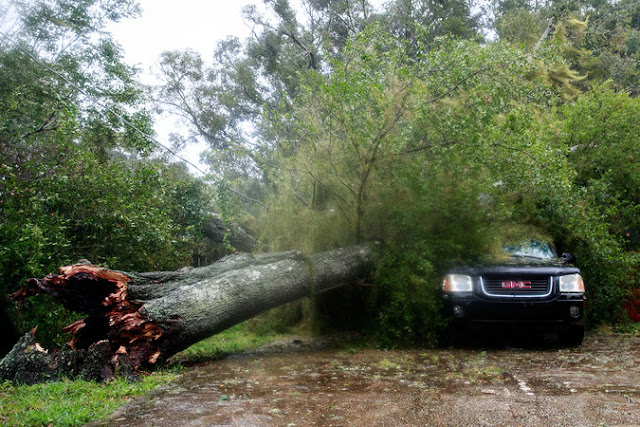
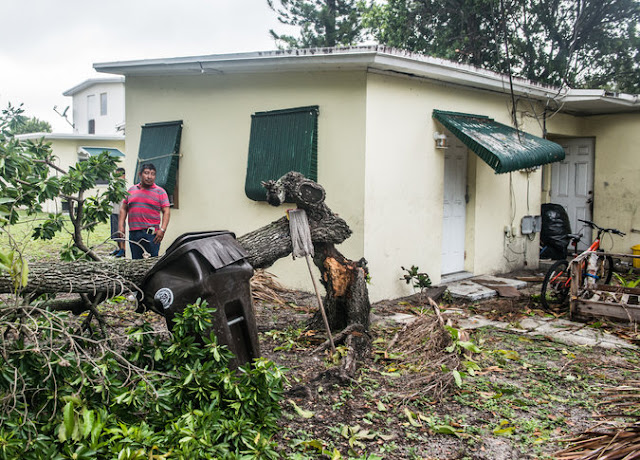
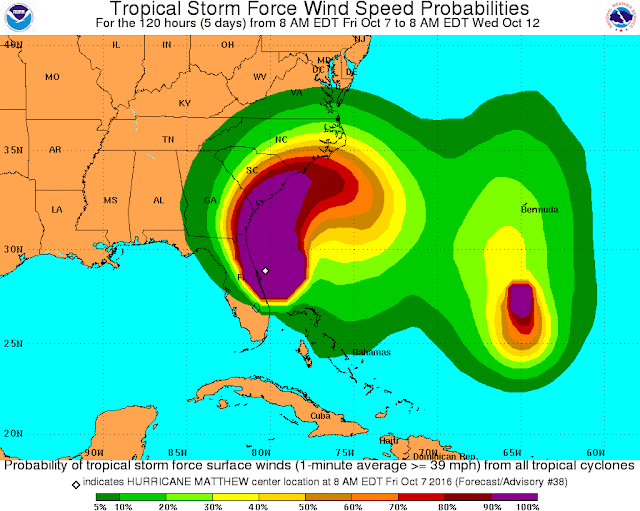




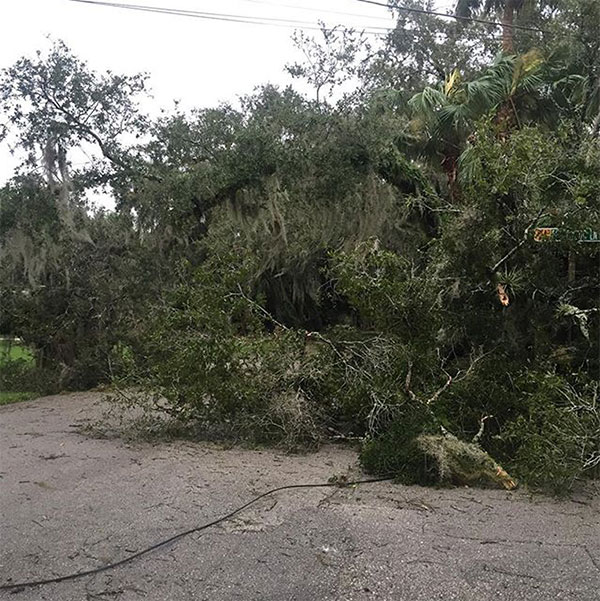
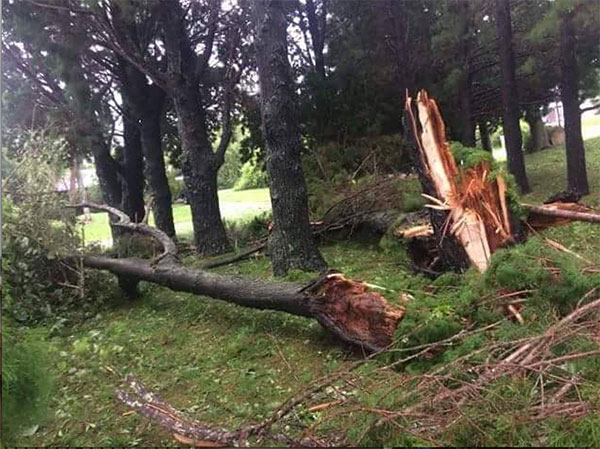
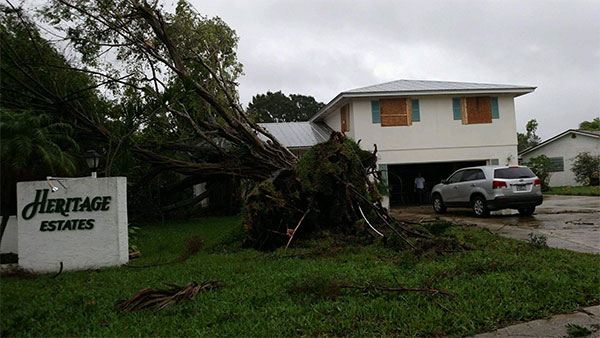
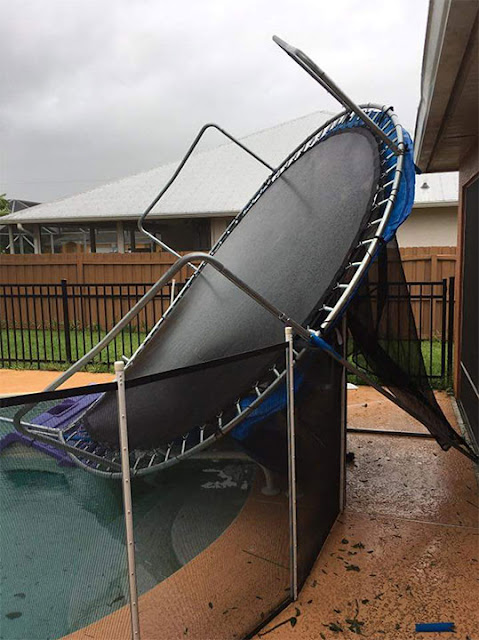

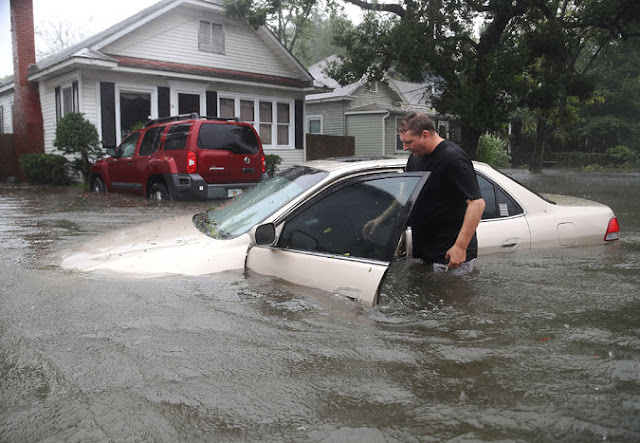
Hurricane Matthew downgraded to Category 2 as it moves along coast
1 million without power
UPDATED 10:03 PM EDT Oct 07, 2016
ST. AUGUSTINE, Fla. —Hurricane Matthew spared Florida's most heavily populated stretch from a catastrophic blow Friday but threatened some of the South's most historic and picturesque cities with ruinous flooding and wind damage as it pushed its way up the coastline.
Among the cities in the crosshairs were St. Augustine, Florida; Savannah, Georgia; and Charleston, South Carolina.
"There are houses that will probably not ever be the same again or not even be there," St. Augustine Mayor Nancy Shaver lamented as battleship-gray floodwaters coursed through the streets of the 451-year-old city founded by the Spanish.
Matthew - the most powerful hurricane to threaten the Atlantic Seaboard in over a decade - set off alarm as it closed in on the U.S., having left more than 300 people dead in Haiti.
In the end, it sideswiped Florida's Atlantic coast early Friday, swamping streets, toppling trees onto homes and knocking out power to more than 1 million people. But it stayed just far enough offshore to prevent major damage to cities like Miami, Fort Lauderdale and West Palm Beach. And the coast never felt the full force of its 120 mph winds.
"It looks like we've dodged a bullet," said Rep. Patrick Murphy, a Democrat whose district includes Martin County, just north of West Palm Beach.
Two women died in separate events in Florida. One was killed when a tree fell on her house in the Daytona area and the other died when a tree came down on a camper in Putnam County. A man was also hurt in that instance.
While the hurricane was weakening quickly, several northeastern Florida cities, including Jacksonville, were still in harm's way, along with communities farther up the coast. Authorities warned that not only could Matthew easily turn toward land, it could also cause deadly flooding with its surge of seawater.
The storm gouged out several large sections of the coastal A1A highway north of Daytona Beach, and had nearly completely washed out the northbound lane for about a mile at Flagler Beach.
"It's pretty bad, it's jagged all over the place," said Oliver Shields, whose two-story house is within sight of the highway.
About 500,000 people were under evacuation orders in the Jacksonville area, along with another half-million on the Georgia coast. More than 300,000 fled their homes in South Carolina. The latest forecast showed the storm could also scrape the North Carolina coast.
"If you're hoping it's just going to pass far enough offshore that this isn't a problem anymore - that is a very, very big mistake that you could make that could cost you your life," National Hurricane Center Director Rick Knabb warned.
St. Augustine, which is the nation's oldest permanently occupied European settlement and includes a 17th-century Spanish fortress and many historic homes turned into bed-and-breakfasts, was awash in rain and seawater that authorities said could top 8 feet.
"It's a really serious devastating situation," the mayor of the city of 14,000 said. "The flooding is just going to get higher and higher and higher."
Historic downtown Charleston, usually bustling with tourists who flock to see the city's beautifully maintained antebellum homes, was eerily quiet, with many stores and shops boarded up with plywood and protected by stacks of sandbags.
The city announced a midnight-to-6 a.m. curfew Saturday, around the time the coast was expected to take the brunt of the storm.
Matthew's outer bands began lashing Savannah, a city that was settled in 1733 and has a handsome historic district of moss-draped trees, brick and cobblestone streets, Greek revival mansions and other 18th- and 19th-century homes.
Matthew was expected to bring winds of 50 to 60 mph that could snap branches from the burly live oaks and damage the historic homes. And 8 to 14 inches of rain could bring some street flooding.
Savannah-Chatham County Police Chief Jack Lumpkin said officers will enforce a dusk-until-dawn curfew.
A small crew of workers Thursday set out to button up the Owens-Thomas house, one of Savannah's architectural gems. The 1819 Greek revival mansion serves as a museum.
Sonja Wallen, a curator, said antique rugs and furniture were moved away from the home's more than 40 windows, many of them still with their original8glass. Windows were fitted with plywood and other coverings, while sandbags were stacked at the basement entrance.
"It's basically a lot of little details - sandbags and duct tape around doorways where water can get in," Wallen said. "It's pretty much the same stuff you would do for any home."
Some of Georgia's resort islands were expected to take the brunt of Matthew's storm surge, including St. Simons and Tybee.
On Tybee Island, where most of the 3,000 residents were evacuated, Jeff Dickey held out hope that the storm might shift and spare his home. But as the rain picked up, he decided staying wasn't worth the risk.
"We kind of tried to wait to see if it will tilt more to the east," Dickey said. "But it's go time."
Mayor Jason Buelterman personally called some of the holdouts, hoping to persuade them to move inland.
"This is what happens when you don't have a hurricane for 100 years," he said. "People get complacent."
At 6 p.m. EDT, Matthew was centered about 40 miles east of Jacksonville Beach and 135 miles south of Savannah, and was moving north at 12 mph. Its wind speed had dropped to 110 mph, down from a terrifying 145 mph when it smashed into Haiti.
Airlines canceled at least 5,000 flights Wednesday through Saturday, including many in and out of Orlando, where all three of the resort city's world-famous theme parks - Walt Disney World, Universal Studios and SeaWorld - closed because of the storm.
But things began getting back to normal, with flights resuming in Miami and other South Florida airports.
In areas the storm had already passed, residents and officials began to assess the damage.
Robert Tyler had feared the storm surge would flood his street two blocks from the Cape Canaveral beach. Tree branches fell, he could hear transformers exploding overnight, and the windows seemed as if they were about to blow in, despite the plywood over them.
But in the morning, there wasn't much water, his home didn't appear to be damaged on first inspection, and his vehicles were unharmed.
"Overnight, it was scary as heck," Tyler said. "That description of a freight train is pretty accurate."
LONG BEACH, CA (CBSLA.com) — Firefighters Friday extinguished a structure fire that erupted within a residential building in Long Beach.
The fire broke out shortly after 1:30 a.m. int he 5100 block of Cedar Avenue, according to firefighters.
Upon their arrival, crews located four garages and one vacant residence that were engulfed by flames.
Firefighters said downed power lines energized a nearby fence and building, and subsequently shocked three firefighters on scene.
They were evaluated and transported to a hospital for treatment of injuries.
The firefighters were reported to be in stable condition, according to hospital officials.
The cause of the fire remains under investigation.
Steelworker who died told wife mill was getting less safe
Joseph S. Pete joseph.pete@nwi.com, (219) 933-3316
Updated Oct 6, 2016
Jonathan Arizzola, a Navy veteran who deployed to Pakistan on a humanitarian mission, had suffered an electric shock in a separate accident at Gary Works the week before his death and had frequently told his wife it was getting dangerous there.
Arizzola died Friday night in an accident while working in a four-man crew assigned to troubleshoot a crane at the U.S. Steel slab storage yard in Gary.
The overhead cranes can span four stories and are used to hoist
steel coils around the plant.
The 30-year-old Valparaiso resident was an electrician who worked at the mill for about four years, but was concerned with the deterioration of working conditions at the mill in Gary, his widow Whitney Arizzola said.
“He was constantly complaining about McKinsey group cutting back workers,” she said. “There was always some kind of close call with someone he worked with. I never imagined that something would happen to Jon, he was always the safest guy I knew.”
The United Steelworkers union has been protesting layoffs and the demotion of maintenance workers to labor gangs, including with a rally outside the mill gates. USW officials say the cuts have made the mill less safe, such as by having roving labor gangs work in parts of the 7-mile mill they’re unfamiliar with.
“Our company has decided that, to save a dollar, they’ll farm people out all over this mill which only increases the chances for accidents like these happening,” USW Local 1014 President Rodney Lewis said in a Facebook post to steelworkers. “They should instead be asking themselves if it’s high time they started listening to what we’ve been saying all along. Moving people all around a mill like chess pieces only promises to result in something tragic. Shutting down training when you need it the most is just bad business when you consider that we are ‘the company’s most important asset.’”
Bare-bones crews at Gary Works put steelworkers at risk for more accidents, Lewis said.
“Bad news is not an if, but a when,” he said. “As terrible as it sounds, haven’t we been saying that something was coming?”
U.S. Steel declined to comment on safety criticisms.
Arizzola had an 8-year-old son and a son who turns 5 this week. He had served as an electrician on the USS Peleliu amphibious assault ship and was very proud of the military, even recently buying a soldier’s meal at El Salto.
“All they care about is making money,” Whitney Arizzola said. “They don’t care that it affects other people. He has a 4-year-old who’s turning 5. They keep cutting when they should have a safer environment for people. It shouldn’t be all about the money.”
His loss has been hard on their family.
“I have no husband now, my children have no father,” she said. “I have no idea how I’m going to pay for my house or my car, any of our bills, I was a stay at home mother. I have no experiences, Jon was everything to me.”
A GoFundMe page at www.gofundme.com/2s8p4s2c has been set up to help his family.
=======
 A steelworker was killed at U.S. Steel’s Gary Works plant last Friday. It’s the second death there this year, and it comes amid rising tensions over safety and staffing at the plant.
A steelworker was killed at U.S. Steel’s Gary Works plant last Friday. It’s the second death there this year, and it comes amid rising tensions over safety and staffing at the plant.
Data from the Occupational Safety and Health Administration shows 28 primary metal manufacturing workers were killed on the job across the country in 2014. Two of those deaths were in Indiana, about average for the past few years.
In the past few months, there have been two deaths at Gary Works, which is the largest steel mill in North America: 67-year-old electrician Charles Kremke, fatally electrocuted in June, and 30-year-old Jonathon Arrizola, killed last week while doing maintenance on a crane.
Some employees are blaming recent layoffs for those deaths.
A post in a public United Steelworkers Facebook group, signed by Local 1014 president Rodney Lewis, says the August layoffs of 75 Gary Works maintenance staff and pay cuts for 200 more have jeopardized safety — forcing fewer workers to cover more tasks.
“Working with bare bones crews ain’t cutting it. Bad news is not an if, but a WHEN,” Lewis says in the post. “As terrible as it sounds haven’t we been saying that something was coming??”
The layoffs sparked protests and a union complaint, which is being handled through a third-party arbiter.
U.S. Steel spokesperson Sarah Cassella declined to comment on that complaint. She also declined to release more details on the worker deaths, but said in an email that the company is investigating along with the union and federal agencies.
=======

The night before Herbie Tolman took the electrician's test at Gary
Works, the steel plant in Gary, Indiana, he was up all night vomiting.
It
wasn't just that this was a chance at a secure full-time job, and that
ever since high school, Herbie always seemed to be bouncing around – one
year as a bartender, another running his own crane repair business, yet
another working in some of the other local steel mills. Nor was it
simply the money, though the $75,000 starting salary would triple the
income from odd jobs that he was bringing in to support his wife, Randa,
and their two young children, Sydney and Cameron.
More than
anything else, a job at Gary Works meant being part of U.S. Steel, the
legendary Pittsburgh company founded in 1901 by J.P. Morgan, Charles
Schwab and Andrew Carnegie, and America's most prolific steel producer
ever since. Gary Works, as it happened, was U.S. Steel's largest plant, a
mammoth 3,000-acre facility on the southern shore of Lake Michigan,
belching out some 7.5 million tons of steel products ever year to make
cars, buildings and home appliances.
Most people in the city of
Gary and the surrounding blue collar steel towns, the soul of this part
of Indiana for over a hundred years, knew that it was hard to do better
than Gary Works, especially if, like Herbie Tolman, you didn't have a
college degree. It was the kind of job where, if you were lucky enough
to get hired, you were proud to remind neighbors and relatives where you
worked; the kind of job where you'd throw on a U.S. Steel T-shirt every
time you drove into town, slap company bumpers stickers on your car and
join the ranks of one of the United Steelworkers of America (USWA)
local unions; the kind of job where you'd most likely have food on your
family's table until the day you died.
Randa's father, Randall,
had worked as a crane repairman at Gary Works for over 30 years fixing
the overhead cranes which could span four stories and were used to hoist
steel coils around the plant. And he had put in the good word for his
son-in-law with the company. Now it was up to Herbie to take the
electrician's test and make it in.
And Herbie wanted to pass the test so bad, wanted the job so bad, that he ended up being sick all night, throwing up.
Herbie
felt better the next day, took the test and made it. "His whole world
changed when he found out about the job," Randa says. "He was so proud."
Over
the next five years, Herbie would talk about how much he loved his work
to anyone who'd listen – Randa, the kids, even his mother, who he'd
call from the plant to talk about what he'd been fixing that day. He
especially liked to chat cheerfully about work with Pete Shaffer, his
close friend and crane repair crewmate, as they'd change brushes and
tips and repair motors on the old cranes. Pete would sometimes joke
about how he couldn't shut Herbie up, but Herbie would just laugh. At
39, this was what Herbie had always dreamed of doing, and he was glad
everyone knew it.
"Herbie talked about his job around the clock,
and he was good at it too," Shaffer remembers. "He was just really a
charismatic guy. Everyone liked him."
And then came that fateful
autumn day last September. Randa woke with Herbie at 4 AM as she always
did, to see him off to work. She'd made him a cup of coffee as usual,
knowing he'd likely leave most of it and grab a second cup from the gas
station down the street as was his ritual.
As Randa readied
herself for a school field trip with Sydney to a farm outside of town,
Herbie told her he'd be cooking the steaks and vegetables out on the
grill that night. Randa smiled to herself. Herbie loved to cook,
especially when he could grill outside in their backyard. Truth be told,
he did more cooking than she did, which was fine with her because she
always said that if Herbie hadn't been a steel man, he would have been a
gourmet chef.
"Have a great time on that field trip," Herbie grinned back, before closing the door behind him.
That
afternoon, as Randa was driving back home from the field trip with
Sydney, she thought of Herbie hunched diligently over the grill – the
tiki torches he'd posted around the backyard flickering from the whisper
of cool, western Indiana autumn air as the sweet smoke from the fresh
corn and steaks filled the air.
Almost a soon as they got home,
Randa heard the van roar into the driveway. Then the strong, hurried
footsteps, followed by loud knocking. There were six of them standing
there when she opened the door.
"Yes?"
"Mrs. Tolman?"
"Yes."
"We're from U.S. Steel."
"Yes..."
"There's been an accident. You have to come with us."
It
had been a massive 1,600-pound wheel from one of the overhead cranes
which did it, they said. Herbie had been working on it and the wheel
just fell, suddenly, and crushed him. They told her that Herbie had died
around 11 AM, and that he was gone the moment it hit him.
At the
hospital, Herbie looked like he was sleeping too – clean shaven, a
white sheet tucked under his chin, the same grin with which he'd left
her on his lips, fresh blood leaking out of both his ears. According to
the Lake County Coroner's report, the wheel had flown into Herbie's
upper body after becoming dislodged from a jack, fracturing his skull
and severely injuring his chest.
That Saturday, friends, families
and workers crammed into the funeral home in Portage, the town where
Herbie and Randa lived just outside of Gary, to pay their respects.
Herbert's union, USWA Local 1066, paid for it all – the food, the
funeral arrangements, everything. Sonny Tolman, Herbie's mother,
couldn't believe how many people were there, at least 1,400 by her
count, including all of her extended family, Herbert's ex-girlfriend
from California, and old friends of her son's she hadn't seen since he
was a boy. "I wanted the biggest sendoff I could have for my son and
that's what we had," she says. "He had so many friends."
Meanwhile,
local newspapers reported that U.S. Steel had fired two of Herbie's
crewmates, including Pete Shaffer, for not following proper safety
precautions just before the accident, and that investigators from the
federal Occupational Health and Safety Administration (OSHA) were at the
plant trying to figure out exactly what happened.
A Spate Of Accidents
Herbie's death was the first at Gary Works in seven years, but there'd been others like it around the country last year.
In
April, Ed Theriot was killed after being trapped between a steel
cooling bed and a rail car from one of the trains which transports
materials around the Bayou Steel Corporation plant in La Place,
Louisiana.
In June, after working more than 20 years at Ispat
International in East Chicago, Indiana, Tony Parker fell 20 feet from
his work platform at the hot metal transfer station and died.
And
just a month before Herbie died, Michael Carney had been crushed to
death by a 35,000-pound roll used to flatten steel, which dropped from
an overhead crane at the Allegheny Ludlum Steel plant in Vandegrift,
Pennsylvania.
All told, after a steady decline in accidents and
deaths at steel plants, USWA reported nine fatalities of its union
members in steel plants in 2004, up from just three in 2003. Already
this year, USWA says six workers have been killed in steel-related
accidents, including Velma Burnette, crushed by a loose load of steel at
the Republic Engineer Plant in Loraine, Ohio on January 27, the first
woman killed at the plant in 40 years.
Explanations as to why
this is happening are complex and differ depending on who's giving them,
but there's clearly more than one factor involved. Certainly steel work
has always been dangerous – most plants have hundreds of employees
working skilled jobs with heavy equipment, molten metal and other
combustibles and sometimes at dangerous heights. But over the past 20
years, automation of much of what occurs inside the plants has
drastically reduced fatalities and accidents.
During the same
period however, steel production at U.S. plants plummeted, largely
because of foreign competition and an over-saturation of steel on the
market. American plants downsized or closed, steel companies filed for
bankruptcy and thousands of experienced workers were hustled off into
generous early-retirement programs negotiated by the union.
But
then, in recent years, a worldwide steel boom began to change the
industry's fate and American steel plants have fired up production once
again. According to the American Iron and Steel Institute, U.S. steel
plants shipped off nearly six percent more product in 2004 than in 2003,
and approximately 12 percent more than in 2002.
But while
business is good, steel companies have suddenly found themselves without
the "old timers," as they're called, whose mastery of their own
specialized crafts has been particularly missed now that there's more
work to be done. Ostensibly, a far younger, less experienced generation
of workers like Herbie Tolman, have been thrust into technically
demanding and often dangerous jobs without many of the veterans there to
show them the safest way to work.
Unsure of how long the boom
will last, steel companies have been reluctant to rehire, despite the
fact that during the downturn, crew sizes were scaled down and safety
and preventative maintenance staff reduced, says Mike Wright, director
of health, safety and environment for USWA.
To meet the increased
demand in production, many companies did the next best thing: they
signed labor agreements with the USWA which allowed workers to be
shifted from the job they'd initially trained for, to different
departments within the plant. Indeed, more work, less knowledge and a
reduced emphasis on safety have all contributed to the problem, it
seems.
"The workers have been under extraordinary pressure,"
Wright says. This past summer, when it became apparent that the spate of
fatalities in steel plants needed desperately to be addressed, three
steel trade associations representing many of the major steel companies
signed an alliance with OSHA to address safety concerns.
But they
left the unions out of the alliance. USWA president Leo Gerard blasted
the alliance in a July 8 statement, saying "If they were really
interested in safety, they would have turned to the men and women who
make these plants run."
An OSHA spokesman defended the decision
saying that the trade associations did not want the union involved, at
least at first, but that OSHA was open to engaging in a separate safety
cooperative with the union.
Faced with the more immediate problem
of how to handle the accidents at their own plants, many steel
companies also began dealing with the situation individually, albeit in
varying degrees.
According to the Wall Street Journal,
Bayou Steel installed an automatic shut off switch on its rail cars
after Ed Theriot was killed, and another company, International Steel
Group, brought union representatives and company officials together to
devise more stringent safety standards for its workers.
Last
summer, after a series of non-fatal accidents and before Herbie Tolman
died, U.S. Steel shut down all of its plants for one hour to talk safety
with its workers. The company subsequently launched a reassessment of
safety procedures for all of its jobs, and has sent officials out to
plants to discuss working conditions.
But there's an underbelly
to this safety-consciousness, says the union. U.S. Steel, says the USWA,
has also been doing something very dangerous – disciplining employees
for reporting injuries and accidents, and in the process forcing
workers to think twice about coming forward when something in the plant
has gone wrong.
"If there's an injury now, discipline often
follows," says Wright. "And as a result, people just aren't reporting
what's happening, so you lose basic information on how to make a plant
safer."
Local union representatives at other U.S. Steel plants
echo Wright's concern. Some workers at Granite City Works in Granite
City, Illinois, say that since U.S. Steel took over the plant in 2003,
their jobs have become considerably more dangerous, in part because,
they say, the company discourages workers from reporting injuries or
unsafe conditions.
"At this plant, if you're worried about the
safety of the job you're doing, then you are considered insubordinate,"
says Gary Gaines, financial secretary for Granite City Works USWA Local
1899. "This company refuses to acknowledge that there are hazards in the
steel industry."
Last December, one worker at the plant, Karl
Richards, was killed from carbon monoxide poisoning while adjusting a
valve on a blast furnace, and in February, another worker, David
Prengel, was crushed against a loading dock by a cargo train.
John
Armstrong, spokesman for U.S. Steel, would not comment on the
disciplining of workers for reporting injuries or unsafe conditions, or
on what the company was doing to improve safety at its plants. Nor would
he say much about Herbie Tolman's death. "This was a terrible tragedy,
and we've said everything we're going to say," Armstrong said. "We're
not going to rehash this in the media another time."
On January
31, however, Indiana's OSHA office fined U.S. Steel a total of $6,125
for two serious violations involving Herbie Tolman's death. According to
OSHA documents, the crane wheel Herbie's crew was working on was not
properly cribbed or secured as it should have been, and the electrical
extension cord the crew had used was damaged, exposing live wire.
Pete
Shaffer, whose arms Herbie died in, is filing a grievance against U.S.
Steel to get his job back, as is another co-worker, also fired after the
accident. Their union is representing the workers and the process is
likely to take months.
As for Randa Tolman, the $588 a week in
workers compensation money she gets from the state is hardly enough to
pay the bills and support two kids. U.S. Steel told her that Herbie's
health insurance would be cut off, and it has, she says. In the
meantime, Randa has hired attorneys and is considering legal action
against the company in her husband's death.
What hurts the most,
Randa says, is that U.S. Steel has yet to call or write to say how sorry
it is about Herbie. In the end, she knows that's what he would have
wanted.
"Not one person has called from Pittsburgh, not one
person! Couldn't they have done that?" she wonders. "Herbie was so proud
of that job. He loved it so much. I still can't believe he's never
coming back."
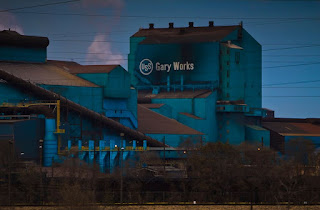
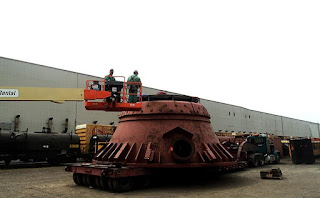
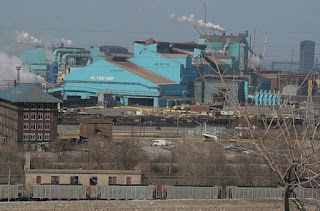
MIOSHA takes aim at hazards encountered during blight removal
October 5, 2016
Lansing, MI – The Michigan Occupational Safety and Health Administration is looking to protect workers from hazards linked to asbestos, lead and cadmium that may be encountered during blight removal projects, as part of a one-year state emphasis program launched in September.
The program will focus mainly on residential jobsites. MIOSHA said it will increase inspections at blight removal jobsites and work with employers during each inspection to help them identify hazards.
“As Michigan continues to eliminate blight and revitalize its neighborhoods, it’s especially important that the men and women working on these projects are protected from potential health hazards,” MIOSHA Acting Director Bart Pickelman said in a press release “MIOSHA will be inspecting more jobsites to ensure employees involved in blight cleanup are properly trained, protected and equipped to work with hazardous materials in a safe manner.”
=======
MIOSHA Targets Blight Removal Projects to Protect Workers from Asbestos and Other Hazards
Media Contact: LARA Communications 517-373-9280
Consumer Contact: 800-866-4674
Email: mediainfo@michigan.gov
September 7, 2016 – The Michigan Occupational Safety and Health Administration (MIOSHA) has launched a state emphasis program that will increase MIOSHA presence on blight removal projects across the state to address hazards such as asbestos and lead that pose health threats to workers. MIOSHA is part of the Michigan Department of Licensing and Regulatory Affairs (LARA).
In 2010, the U.S. Department of the Treasury provided assistance to states most severely impacted by the foreclosure crisis. Michigan received additional funding for blight removal in 2016, predominantly in the Cities of Detroit and Flint.
During the year-long program, MIOSHA will inspect mostly residential blight removal jobsites for hazards associated with asbestos, lead and cadmium, as well as all other serous hazards.
“As Michigan continues to eliminate blight and revitalize its neighborhoods, its especially important that the men and women working on these projects are protected from potential health hazards,” said MIOSHA Acting Director Bart Pickelman. “Beginning this month, MIOSHA will be inspecting more jobsites to ensure employees involved in blight cleanup are properly trained, protected and equipped to work with hazardous materials in a safe manner.”
Blight reduction hazards include materials within structural members such as lead, asbestos, cadmium, silica and other chemicals or heavy metals requiring special material handling. During each inspection, the agency will work with employers to assist them in identifying hazards that are associated with these hazardous work operations.
MIOSHA’s Asbestos Program ensures that people working with asbestos are properly trained and the individuals performing asbestos removal comply with rules governing the work activity. Contractors performing friable asbestos removal or encapsulation work in Michigan must provide project notifications indicating the start and end dates and other job-related information to the Asbestos Program within a specified time frame.
By Kaitlyn Schwers
kschwers@bnd.com
OCTOBER 7, 2016
Shiloh, IL
A Shiloh police officer used a canvas strap to pull a construction worker from a puddle of electrified water Friday morning, then a second officer used chest compressions to revive the man.
Shiloh Police Chief Jim Stover said the accident happened behind the police department a few minutes after 8:45 a.m. It resulted in two workers being taken to the hospital by an O’Fallon ambulance crew.
Stover said officers responded to a call at a construction site outside Wilke Window & Door. Officers found one worker in some water. The worker was unconscious and “had no heartbeat,” Stover said.
Stover said the worker appeared to have been using a saw to cut concrete. Police said a second worker tried to pull the first worker out of the water, but was unsuccessful. Stover said the second worker was not seriously injured, but had “a very visible reaction to being shocked.”
That’s when the two Shiloh officers took action. Stover said Officer Brad Blake used a canvas tie strap to pull the worker from the water. Another officer, Mark Geyer, started performing chest compressions to get him breathing. The man was stabilized after Blake used a defibrillator.
Stover said the worker appeared to be breathing by the time an ambulance crew took him to the hospital. Information on his condition was not immediately available later Friday, but police said they expect him to recover.
“In my opinion, if my two officers had not used the professional training they received, I don’t believe the victim would have survived until our ambulance got there,” Stover said. “It was a challenge to get him out from where he was, but everyone worked together.”
In my opinion, if my two officers had not used the professional training they received, I don’t believe the victim would have survived until our ambulance got there. It was a challenge to get him out from where he was, but everyone worked together.
Shiloh Police Chief Jim Stover
The Fairview Heights office of the Occupational Safety and Health Administration said it was notified of the accident. Karl Armstrong, assistant area director, said OSHA did not have the name of the construction company that employs the two workers, and said the agency was “just beginning the investigation” by Friday afternoon.
A message to the owner of the Wilke company was not immediately returned by Friday afternoon.
O’Fallon Fire Chief Brent Saunders had confirmed earlier Friday that two people were taken by ambulance to a hospital after they were hurt in an “electrical incident” outside a business in the 3500 block of Lebanon Avenue in Shiloh.
An Ameren Illinois crew was called as a precaution, the fire chief said, but the electric company was not involved.
The workers were using electric saw to cut the concrete and it is possible that the electric cord was damaged and was immersed in water; the electrified water then shocked the workers.


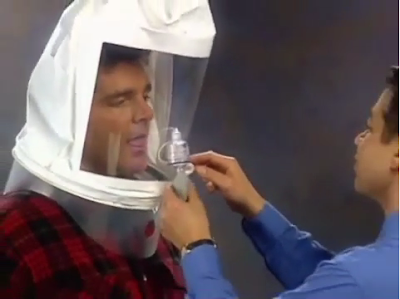

OSHA Trade Release 
U.S. Department of Labor
Occupational Safety and Health Administration
Office of Communications
Washington, D.C.
www.osha.gov
For Immediate Release
October 6, 2016
Contact: Office of Communications
Phone: 202-693-1999
OSHA proposes to amend respiratory protection standard to add
two additional fit-testing protocols
WASHINGTON - The Occupational Safety and Health Administration today issued a Notice of Proposed Rulemaking to add two quantitative fit-testing protocols to the agency's Respiratory Protection Standard. The protocols would apply to employers in the general, shipyard and construction industries.
Appendix A of the standard contains mandatory respirator fit-testing methods that employers must use to ensure their employees' respirators fit properly and protect the wearer. The standard also allows individuals to submit new fit-test protocols for OSHA approval. TSI Incorporated submitted an application for new protocols for full-facepiece and half-mask elastomeric respirators, and filtering facepiece respirators.
The existing standard contains mandatory testing methods to ensure that employees' respirators fit properly and are protective. The standard also states that additional fit-test protocols may be submitted for OSHA approval. TSI Incorporated submitted an application for new protocols for full-facepiece and half-mask elastomeric respirators, and filtering facepiece respirators. The proposed protocols are variations of the existing OSHA-accepted PortaCount® protocol, but differ from it by the exercise sets, exercise duration, and sampling sequence.
The agency invites the public to comment on the accuracy and reliability of the proposed protocols, their effectiveness in detecting respirator leakage, and their usefulness in selecting respirators that will protect employees from airborne contaminants in the workplace. More specific issues for public comment are listed in the Federal Register notice.
Individuals may submit comments electronically at www.regulations.gov, the Federal e-Rulemaking Portal. Comments may also be submitted by mail or facsimile; see the Federal Register notice for details. The deadline for submitting comments is Dec. 6, 2016.
This proposed rulemaking would allow employers greater flexibility in choosing fit-testing methods for employees. The proposed rule would not require an employer to update or replace current fit-testing methods, as long as the fit-testing method(s) currently in use meet existing standards. The proposal also would not impose additional costs on any private- or public-sector entity.
Under the Occupational Safety and Health Act of 1970, employers are responsible for providing safe and healthful workplaces for their employees. OSHA's role is to ensure these conditions for America's working men and women by setting and enforcing standards, and providing training, education and assistance. For more information, visit www.osha.gov.
###

A police official, center, escorts two men outside the court in Thane, outskirts of Mumbai, India, Thursday, Oct. 6, 2016. ((AP Photo/Rajanish Kakade))
Friday, October 07, 2016 02:57PM
NEW DELHI -- Indian police have arrested 70 people and are questioning hundreds more after uncovering a massive scam to cheat thousands of Americans out of millions of dollars by posing as U.S. tax authorities and demanding unpaid taxes, a police officer said Thursday.
According to police in Mumbai, the yearlong scam involved running fake call centers which sent voice mail messages telling U.S. nationals to call back because they owed back taxes.
Those who called back and believed the threats would fork out thousands of dollars to "settle" their case, Mumbai police officer Parag Marere said Thursday.
The scam brought in more than $150,000 a day, Marere said without giving a total sum. If the scam netted that amount daily, it would have made almost $55 million in one year.
Some victims were also told to buy gift vouchers from various companies, and hand over the voucher ID numbers which the impostors then used to make purchases, Marere said.
Police said they are likely to file charges against many of the 600 or more people still being questioned on suspicion of running the fake call centers, housed on several stories of a Mumbai office building.
Those arrested so far include several of the alleged ringleaders, as well as people accused of providing equipment and setting up the fake call centers. The criminal charges filed against the suspects include extortion, impersonation and violations of India's information technology laws.
"We are questioning those who were involved in the fraud, including those posing as tax investigators," Marere said.
Police raided the offices this week and seized hundreds of hard disks, hard disks, high-end servers and other electronic equipment.
Indian media reports said 70 percent of the scam's proceeds were retained by the suspects in India, while the rest was paid to collaborators in the U.S.
Indian news broadcaster NDTV reported that one U.S.-based company allegedly collected the victims' personal information and passed it to the fake call centers.
========
Indian Police Arrest 70 Tied to $55 Million U.S. Tax Scam
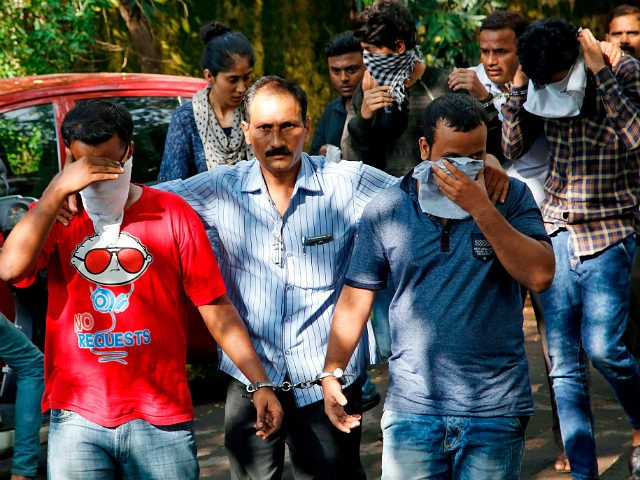
AP Photo/Rajanish Kakade
by John Hayward
6 October 2016
Indian police announced at least 70 arrests on Thursday in connection with a massive telephone scam to cheat American taxpayers out of phony “back taxes.”
This was an all-too-familiar scam that hit Americans with recorded messages, purportedly from the Internal Revenue Service, informing the victim that back taxes were due, and a lawsuit was imminent. The victim was encouraged to call back and arrange emergency payments to “settle” the IRS case. Some targets were bilked out of thousands of dollars.
The Associated Press quotes Mumbai police saying the scam “brought in more than $150,000 a day,” which would make the operation worth almost $55 million per year. The Wall Street Journal says the ersatz call centers were making thousands of calls per day.
“Some victims were also told to buy gift vouchers from various companies, and hand over the voucher ID numbers which the impostors then used to make purchases,” the police added.
Up to 600 people could ultimately face charges including “extortion, impersonation and violations of India’s information technology laws” for their role in the operation, which was big enough to fill several stories of an office building in Mumbai. Hundreds of hard drives, high-end servers, and other electronics have been seized.
The gang had accomplices in the United States, who provided personal information on the victims, and took a 30 percent cut of the loot.
“U.S. authorities have struggled to combat an epidemic of swindlers targeting taxpayers. The Treasury Inspector General for Tax Administration, an IRS watchdog, said it has received more than 1.7 million complaints in the last three years from people reporting phone calls from swindlers impersonating IRS agents. More than 8,800 victims have paid more than $47 million as a result of these scams,” the Wall Street Journal reports.
The New York Times states that an inside informant helped to bring the Mumbai operation down after it had been up and running for about a year. Owners and operators of the scam were reportedly “stunned to see the police” because “they never thought that police would raid them.”
The NYT describes how the operation used cell phone text message to frighten Americans into handing over their money:
The call center employees would send mass text messages announcing an urgent inquiry to as many as 10,000 American cellphone numbers, said Parag Manere, deputy commissioner of police in Thane, in the western state of Maharashtra.
If recipients called back, the call center employees would introduce themselves as “Christopher or Daniel” and speak with an American accent, impersonating I.R.S. officers.
They would then warn the victims that the local police or I.R.S. agents would raid their homes within 30 minutes unless they sent an immediate payment, said Makarand Ranade, another Thane police official.
Another phone scam reported to the IRS involved threatening voice messages. It’s not clear from the New York Times account if the gang sending the text messages was also behind these robocalls, although the report does mention that seven distinct call centers associated with the crime ring were operating out of the same building.
(Source: KPHO/KTVK)
PHOENIX (KPHO/KTVK) -
Worker electrocuted at commercial building in west Phoenix
Posted: Oct 03, 2016 12:46 PM EST Updated: Oct 03, 2016 6:41 PM EST
By Phil Benson
A contractor working at a commercial building in Phoenix was electrocuted Monday morning, Phoenix Fire Capt. Aaron Ernsberger confirmed.
A number of police and fire units were at the scene near 75th Avenue and Buckeye Road.
"The electrician, an adult male, was unable to be revived from his injuries," Ernsberger said in an email.
Authorities were investigating events leading up to the accident.
The victim's name was being withheld until family and relatives could be notified.
=====
An electrical contractor working on a commercial building near 75th Avenue and Buckeye Road in west Phoenix was electrocuted Monday morning, fire officials said.
The dead man's identity and the cause of the accident were not immediately known, according to Capt. Aaron Ernsberger, Phoenix Fire Department spokesman.
Power was shut off in a small area near the accident, according to Scott Harelson, Salt River Project spokesman.
The Fire Department alerted SRP of the electrocution at 7225 W. Sherman St., and SRP sent troubleshooters to the scene to assist, Harelson said.
The person who was electrocuted was not an SRP employee, he said.





